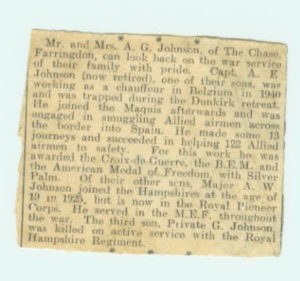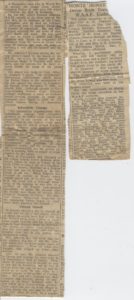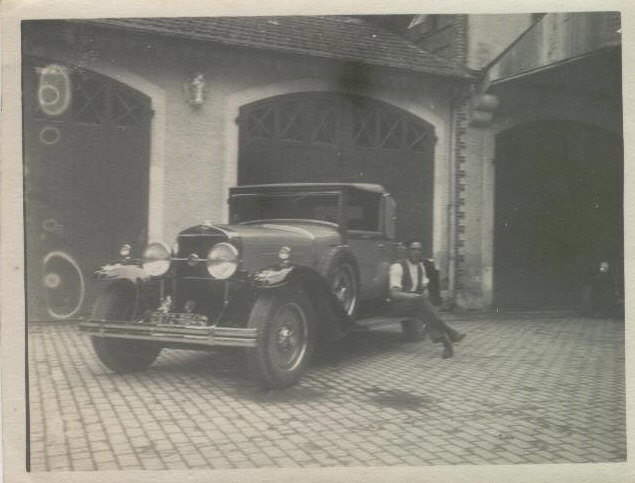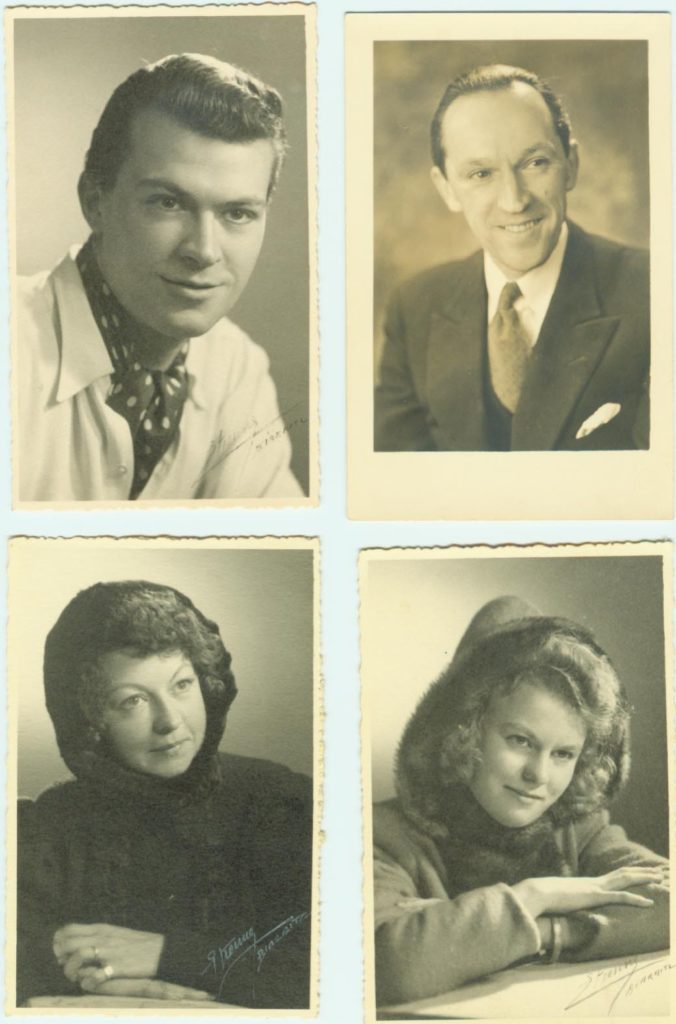Albert Edward Johnson, known as Albert Jonion in France, or simply as ‘B’, was born at Farringdon, near Alton in Hampshire in 1908. His father was Arthur George Johnson from Grantham in Lincolnshire. ‘B’ was a very quiet man who rarely talked about himself to other people. He trained as a motor mechanic, was a good driver, and in 1928, became chauffer and travel secretary to the President of the International Olympic Committee in Brussels.
In May 1940, at the time of the Dunkirk withdrawal, all British citizens were advised to leave Belgium and return to England. Johnson and other staff left Brussels and headed for the south of France, only to find that the Spanish border had been closed. Unable to escape, Johnson met up with the De Greef family from Brussels, who had also been stopped at the Spanish border. Johnson took employment as a gardener and handyman with the De Greefs, and was given accommodation.
When the Comète Line was established, Mme Elvire de Greef, her husband Fernand, daughter Janine and son Freddy, all became part of the organisation. The De Greef house, the Villa Voisin, at Anglet became the main safe-house in the town, and Elvire became the safe-house organiser in the Bayonne area. Most evaders stayed at her Anglet home prior to moving to Francia Usandizandiga’s safe-house just before the crossing of the River Bidassoa.
‘B’ Johnson was an integral part of the organisation from the very beginning. He was responsible for taking the second and third Comète evaders into Spain – Scottish soldiers Cowan (Glasgow Highlanders), and Conville (Queens Own Cameron Highlanders) – on the 17 October 1941. Both men had fought with the 51 Highland Division at St Valery.
‘B’ subsequently led many more evaders to freedom. Then, on the 14 January 1943, when Johnson made his way to Francia Usandizaga’s farmhouse at Urrugne he found the house sealed. Francia, together with Andrée de Jongh and three airmen who had been sheltering there prior to a border crossing, had been betrayed and taken to St Jean de Luz prison for interrogation.
Elvire de Greef used all her contacts and, together with Johnson, made plans to release Andree de Jongh and Francia from the prison. Jean-Francois Nothomb (Franco), arrived from Belgium to assist the rescue party. The initial plan was for Johnson, Franco, and Jean Dassie to scale the prison wall with ropes; this proved unsuccessful. A second plan entailed Johnson and Franco entering the prison in stolen German uniforms on the 03 February, but this had to be aborted at the last minute because Andrée de Jongh had been moved to Biarritz prison. Then the Germans moved her once again, this time to Northern France.
In all, Johnson made 13 double crossings of the Pyrenees, taking with him 122 evaders into Spain. He was, however, later compromised and arrested by the Germans together with Elvire de Greef, who, using her husband’s knowledge of the black market dealings of the Germans in the area, and threatening to expose them to the German Higher Command, managed to get them both released within 24hrs. It had now become too dangerous for Johnson, one of the line’s most dedicated workers to stay in France. He followed the Comete trail into Spain, reached London, and worked for MI9. Later he returned to France to work with the Awards Bureau, a Paris branch of MI9, where he met his future wife Wendy. She had also been a helper in Paris. They married in Devon in April 1946, and returned to Paris to continue working for the Awards Bureau. In October 1946, the Bureau was disbanded, and the couple returned to Devon where their three children were born.
In 1951, it was Australia’s request for British immigrants that provided the catalyst for the family move to Australia. They left England in July 1952, settling in Opossom Bay, Tasmania, 40km south of Hobart. Initially working for the Hydro Electric Company, Johnson later worked for the Statistics Bureau and commuted to Hobart daily. Around this time he started to feel stomach pains, which he had first experienced before leaving England, but it was not until March 1953, after an exploratory operation, that cancer was diagnosed. By October his condition had worsened and the family moved to Hobart to be nearer to hospital help. ‘B’ died in St John’s Hospital, Hobart, on the 3rd February 1954, just 45 years of age.
For his work during the war ‘B’ Johnson was awarded the BEM, the Croix de Guerre and the American Medal of Freedom with Silver Palm, the citation for which states:
For exceptional meritorious achievement which aided the United States in the prosecution of the war against the enemy in Continental Europe from December 7th 1942 to March 1943. Although already in German-occupied France, Capt. Johnson willingly undertook a series of brilliant border crossing missions in order to transport into Spain a total of 122 Allied airmen during 13 hazardous journeys. His outstanding organisational skill, indomitable courage and exemplary devotion to the Allied cause contributed materially to the success of the war effort reflecting the highest credit upon himself and the Allied armed forces.
Footnote: As a security and protective measure, Johnson was designated the honorary rank of Captain in the General Service Corps when, as a British civilian, he began work with the escape lines, working on behalf of MI9.




